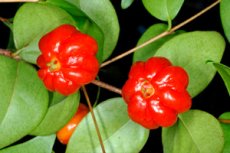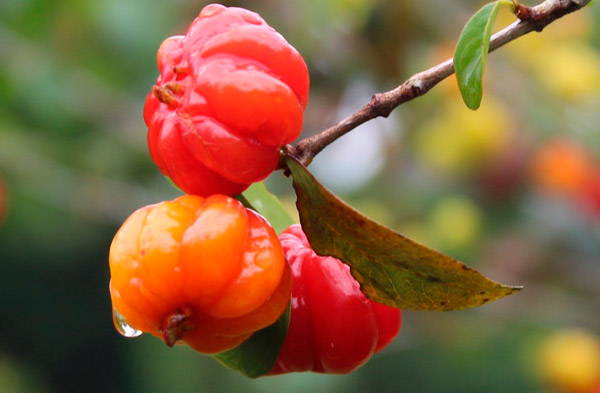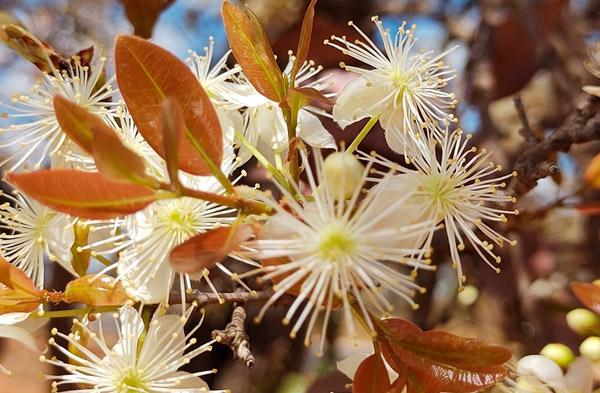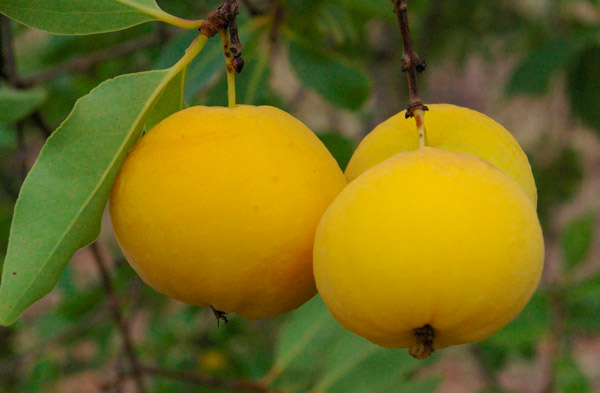New publications
Plants
Eugenia
Last reviewed: 11.03.2025

Eugenia is a genus of plants from the myrtle family, comprising over 1,000 species found in tropical and subtropical regions worldwide. Representatives of this genus often have an attractive appearance with bright green leaves, fragrant flowers, and edible fruits, which can range from small berries to larger fruits. Eugenia is not only a decorative plant but also a source of fruits used in cooking and medicine in various parts of the world.
In ornamental horticulture, Eugenia is valued for its beautiful crown and glossy leaves. It can be a shrub or a small tree, often used for landscaping and as an indoor plant. Eugenia flowers white or pink flowers that bloom in summer. Its fruits are usually edible, though somewhat tart in taste.
Etymology of the name
The name "Eugenia" is derived from the Latin word "eugenia," which in turn comes from the Greek name "Eugenios," meaning "noble" or "descendant of the nobility." The name was chosen in honor of a member of the ancient Greek aristocracy, highlighting the value and significance of these plants. The name also symbolizes the high quality of the fruits, which, like many plants in the genus, are highly valued in culture and cuisine.
In some countries, Eugenia is known by local names based on the appearance of the plant or its fruits, indicating how deeply this plant has become part of cultural traditions in different regions.
Life form
Eugenia can grow in various forms, from compact shrubs to tall trees. In natural conditions, it can reach up to 5 meters in height, while in indoor settings, it often remains much smaller. These plants have dense, dark foliage and may have either upright or spreading branches.
Some species of Eugenia, especially when space is limited and sunlight is insufficient, can be ornamental shrubs, ideal for creating hedges and fences. Other varieties, like those grown for fruits, can develop into small trees with more stable and upright stems.
Family
Eugenia belongs to the myrtle family (Myrtaceae), which includes over 100 genera and more than 3,000 species. The myrtle family is significant both for ornamental gardening and agriculture, encompassing well-known plants such as myrtle, guava, and pimento.
Plants in this family are characterized by vibrant flowers, rich aromas, and beneficial properties used in medicine and cuisine. Eugenia, as a representative of this family, has the characteristic myrtle petals, often white or pink, and fruits rich in vitamins and antioxidants.
Botanical characteristics
Eugenia is an evergreen plant with oval-shaped leaves that have a glossy surface. The leaves are often dark green and may be adorned with various shades. The flowers are usually small, with five petals, which can be white, pink, or cream. The fruits of Eugenia can vary by species, ranging from small berries to larger guava-like fruits.
The root system of Eugenia is well-developed, allowing the plant to be relatively drought-tolerant and capable of growing in areas with limited water. The stems are upright or bushy, covered with smooth bark, which in some species has a reddish hue. Eugenia responds well to pruning, making it suitable for shaping into ornamental forms.
Chemical composition
The fruits and leaves of Eugenia contain several important compounds, including vitamin C, antioxidants, essential oils, and organic acids. The vitamin C in the fruits helps boost the immune system, while the antioxidants promote overall health by protecting cells from free radical damage.
Additionally, the leaves contain essential oils used in aromatherapy for stress relief and relaxation. These oils have antiseptic properties and can be used for disinfection at home or as additives in cosmetics.
Origin
Eugenia is native to the tropical and subtropical regions of America, South and Central Asia, and some islands in the Pacific Ocean. The plant was known and used by local populations for various purposes, from food to medicinal uses. In the 19th century, Eugenia was introduced to Europe, where it quickly gained popularity due to its ornamental appeal and tasty fruits.
Some species of Eugenia were also cultivated in Australia, where the plants adapted to local climatic conditions. In recent decades, Eugenia has become widely used in gardening and as an indoor plant in countries with colder climates.
Ease of cultivation
Eugenia does not require special effort to grow, making it popular among gardeners and houseplant enthusiasts. It can grow outdoors in warm climates or indoors if the necessary conditions are met. The plant is not particularly demanding in terms of soil type but prefers well-drained areas.
Eugenia adapts easily to different conditions, including partial shade, and can thrive with moderate watering. However, to achieve the best results, it is recommended to maintain a regular watering schedule and ensure sufficient sunlight to encourage flowering and fruiting.
Varieties and species
There are several species of Eugenia that vary in size, shape, and type of fruit. One of the most famous species is Eugenia uniflora, or "flavivola," a plant with small, sour fruits often used in making juices and jams. Other species, such as Eugenia dysenterica, produce larger and sweeter fruits that are valued in culinary uses.

Eugenia uniflora

Eugenia dysenterica

Eugenia dysenterica
Varieties of Eugenia can also differ in the shape and color of their foliage. Some species are grown exclusively for their ornamental qualities, while others are cultivated for their fruits.
Size
The size of Eugenia depends on the species and growing conditions. In natural conditions, the plants can grow into tall shrubs or small trees reaching up to 5 meters. However, in indoor environments, Eugenia typically remains more compact, usually not exceeding 1.5-2 meters in height. In indoor conditions, the shrub can be shaped through pruning to limit its growth for easier placement in the home.
Some species, such as Eugenia uniflora, remain smaller and can be grown as dwarf shrubs, making them ideal for indoor settings or small gardens. The size of the plant also depends on how well it adapts to the local climate and the regularity of pruning and care.
Growth rate
Eugenia has a moderate growth rate. In warm climates, where the growing conditions are ideal, it can grow rapidly, especially during the active growing season. With good lighting and moderate watering, the plant can grow several centimeters a month, particularly in the first years of life.
However, in indoor conditions or in colder climates, the growth rate will be much slower. In these cases, the plant will grow more slowly, and its height will be limited by the size of the pot or the lighting conditions. It is also important to note that Eugenia requires periodic pruning to maintain its shape and limit excessive growth.
Lifespan
Eugenia is a perennial plant that can live for several decades with proper care. In its natural habitat, in tropical and subtropical regions, it can grow and bloom for many years, delighting with its beautiful appearance and fruits. In indoor environments, the plant can also live a long life, especially if all care recommendations are followed and the plant is kept in good conditions.
The average lifespan of Eugenia in indoor conditions is around 5-10 years, but with proper care, it can live to a much older age. It is important to provide the plant with optimal growing conditions, avoid extreme temperature fluctuations, and maintain humidity.
Temperature
For normal growth and development, Eugenia's optimal temperature should be within 20-25°C. These plants cannot tolerate frost, so they should be grown indoors in regions with cold winters. If the temperature in the room drops below 15°C, the plant will struggle to maintain its metabolism, which will weaken it.
In the summer, if conditions allow, Eugenia can be moved to open balconies or gardens, providing protection from direct sunlight and excessive heat. In winter, the plant requires more moderate temperatures and should not be exposed to cold drafts.
Humidity
Eugenia prefers high humidity, especially during warm months. To ensure proper development, the humidity level should be maintained between 60-80%. In environments with low humidity, it is particularly important to mist the leaves periodically or use humidifiers to prevent the plant from drying out.
It is also important to remember that despite its high humidity requirements, water stagnation in the roots should be avoided. Therefore, it is essential to maintain good drainage and avoid overwatering, which can lead to root rot and plant diseases.
Lighting and indoor placement
Eugenia prefers bright but diffused sunlight. Ideally, the plant should be placed where it can receive 4-6 hours of sunlight per day, but not direct rays, which can cause leaf burns. The plant can adapt to partial shade, but in such conditions, its growth and flowering will be less intense.
When placing Eugenia indoors, it is important to choose a location where it will receive sufficient light. Windows with southern or western exposure are the best choice. If natural light is insufficient, artificial lighting can be used to provide the necessary level of brightness.
Soil and substrate
Eugenia requires light, well-drained soil. It is recommended to mix universal soil with equal parts perlite, sand, and peat, which will provide good drainage and air permeability. This soil composition will create optimal conditions for the roots and prevent waterlogging, which could lead to root rot.
As for acidity, Eugenia prefers soils with a pH level between 5.5 and 6.5. This is a slightly acidic or neutral pH range that helps with better nutrient absorption. It is important to monitor the substrate’s condition to ensure it is neither too alkaline nor too acidic, as this can negatively affect the plant's growth.
Watering
Watering Eugenia requires attention, as the plant cannot tolerate both drought and overwatering. During the active growing season (spring and summer), watering should be regular but moderate. The soil should remain slightly moist but not waterlogged. It is important to let the top layer of soil dry out a bit before watering again.
In winter, when the plant's growth slows down, watering should be reduced, as high humidity combined with low temperatures can cause root rot. Also, it is important to water with warm water to avoid shock to the roots.
Fertilization and feeding
Eugenia needs regular feeding to maintain healthy growth and flowering. During the active growing season (spring and summer), it is recommended to use a balanced fertilizer for houseplants that contains both macro- and microelements. Liquid fertilizers for ornamental shrubs, applied every 2-3 weeks, work well.
In autumn and winter, when the plant enters dormancy, the amount of fertilizer should be reduced. During this period, fertilizers with low nitrogen content can be used to prevent excessive vegetative growth.
Propagation
Eugenia can be propagated by cuttings as well as by seeds. Propagation by cuttings is faster and more reliable. Cuttings about 10 cm long with several internodes should be taken in late spring or early summer. The cuttings root best in greenhouse conditions or in containers with moist sand and perlite.
Propagating by seeds is more labor-intensive, as the seeds require stratification or soaking beforehand. The seeds should be sown in light soil, and high humidity and warmth should be maintained. The rooting process from seeds can take several months, and the results may not always be successful.
Flowering
Eugenia's flowering is a spectacular event, providing both visual delight and a pleasant fragrance. Eugenia flowers, which are white or pink and star-shaped, appear in late spring or summer, depending on conditions. They are gathered in panicle-like inflorescences and can remain on the plant for an extended period. Flowering typically lasts for several weeks, but insufficient light or excessive watering may prevent the plant from flowering altogether.
To encourage flowering, it is important to create optimal conditions—good lighting and regular watering. Lack of light may result in the plant producing only foliage without blooming.
Seasonal features
In spring and summer, Eugenia is in the active growth phase, requiring more light, warmth, and water. This is the time for flowering and intensive plant development. During this period, it is essential to increase the number of feedings and provide adequate water for the plant.
In autumn and winter, the plant slows down its growth, entering a dormant phase. During this time, watering and feeding should be reduced, and the room temperature should not fall below 15°C. It is important to be cautious with watering to avoid water stagnation in the soil.
Care features
Eugenia does not require complicated care, but it is important to follow a few key conditions to ensure its health. This plant prefers consistent humidity and warm conditions. Pruning to maintain its shape and improve flowering is essential, especially if Eugenia becomes too tall or spreads too much.
In addition to watering and feeding, it is necessary to regularly inspect the plant for pests and diseases. It is also important to avoid waterlogging the soil and to repot Eugenia into larger pots as it grows.
Care in indoor conditions
Indoors, Eugenia should be placed in well-lit areas, preferably near a south- or east-facing window. In winter, the plant should be protected from cold drafts and not placed in areas with low temperatures. To prevent drying out, humidity trays or humidifiers can be used.
Pruning Eugenia also plays a crucial role in plant care. Shaping the bush will prevent excessive spreading and maintain its decorative appearance. After flowering, pruning helps promote the formation of new shoots and prepares the plant for the next season.
Repotting
Eugenia should be repotted as it grows, approximately every 2-3 years. The new pot should be slightly larger than the previous one, but not too large, to avoid overwatering. The pot can be made of plastic or clay, but it is important that it has good drainage holes.
It is best to repot Eugenia in spring, when the plant is actively growing. The repotting process should be done carefully to avoid damaging the roots, and the new pot should provide proper drainage.
Pruning and crown formation
Pruning Eugenia is important not only for shaping a beautiful crown but also for stimulating flowering. After the plant has finished flowering, it is necessary to remove old and dry branches, as well as shorten overly long ones to encourage new growth.
Pruning should be done in early spring so that the plant can adapt to its new shape before the next growing season. Note that pruning should not be too radical to avoid damaging the plant.
Possible problems and solutions
The main problems that Eugenia may face include diseases such as powdery mildew or Phytophthora, which can develop due to excessive humidity. If white spots or fungal damage appear on the leaves, the affected areas should be immediately removed, and the plant should be treated with a fungicide.
Nutrient deficiencies may manifest as yellowing or falling leaves. In this case, proper fertilization, especially during the spring and summer, will help.
Pests
Eugenia can be susceptible to pests like spider mites, scale insects, and aphids. To prevent infestations, regularly inspect the plant and apply insecticides if necessary. It is especially important to maintain optimal humidity, as dry air encourages the development of spider mites.
It is also helpful to periodically wash Eugenia’s leaves with warm, soapy water to prevent dust and pests from accumulating.
Air purification
Eugenia is an excellent indoor plant that helps purify the air by absorbing carbon dioxide and releasing oxygen, making it beneficial for maintaining fresh air in the room. It also helps maintain optimal humidity in the room, which is especially important in winter when indoor air tends to be dry.
Safety
Eugenia is not a toxic plant for humans or pets, but it is always wise to exercise caution, avoid ingesting parts of the plant, and prevent children or animals from chewing on its leaves or fruit. In rare cases, allergic reactions to the plant’s pollen or sap may occur, so if irritation symptoms arise, it is recommended to avoid contact with the plant.
Wintering
In winter, Eugenia should be kept in cooler, frost-free areas. During this time, the plant slows down its growth, and watering should be reduced. The plant can tolerate minor temperature drops down to 15°C, but it does not tolerate cold drafts.
It is important to monitor humidity levels and avoid over-watering, as this can lead to root rot. During winter, Eugenia needs fewer fertilizers, and they should be applied no more than once a month.
Beneficial properties
Eugenia is primarily an ornamental plant, but in some cultures, it has been used for medicinal purposes. Some parts of the plant have antiseptic properties and are used to treat wounds. Extracts and tinctures may contain beneficial elements that support the immune system.
Additionally, the fruits of some Eugenia species are edible and rich in vitamins, making the plant not only decorative but also beneficial for health.
Use in traditional medicine or folk remedies
In traditional medicine, Eugenia fruits were used to treat colds and boost the immune system. Some plant species are also used to improve digestion and normalize stomach function. Eugenia fruits are used to prepare infusions and decoctions that help with inflammation and have antiseptic properties.
Use in landscape design
Eugenia is widely used in landscape design due to its decorative foliage and beautiful flowers. This shrub looks great in both solitary plantings and group compositions. It can be an excellent element for tropical or subtropical-style gardens and can also be used for hedges.
Moreover, Eugenia is suitable for vertical gardening and creating decorative corners in gardens or terraces. Its compact size and beautiful appearance make it a great choice for gardens.
Conclusion
Eugenia is not only a beautiful but also a relatively low-maintenance plant that, with proper care, can become a long-lasting decoration for your home or garden. This plant purifies the air, delights with its flowers and fruits, and requires minimal attention. Eugenia is an excellent choice for those seeking a decorative plant with beneficial properties.
